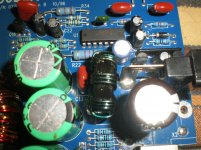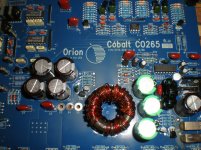Hi,
New here but have browsed for a while. I have learned a lot just reading now I want to try to fix an old amp I picked up for nothing.
My skills are beginner. I can solder well, and having had a good guide restored a Fisher type tube AMP to working condition. (had a good schematic).
Subject:Orion Cobalt 265 XP
Amp looks new out side and in.
Problem: Blows fuse upon putting power to it, this is without speaker or amp turn on being connected.
Observations on my part: Does not blow power supply fuse when amp fuse is removed. I have a DC amp meter and it begins to immediately draw enough to pop a 15amp fuse I used for testing. If I remove power quickly it does not blow the fuse.
The unit has no internal damage that I can see. No burn or black marks nothing dirty, distorted, obviously grounded or dead short arcs.
It only blows after the fuse is in, before the switch on is even added.
I will post photos of the board front and back.
Looking for guidence as I work through this. Its obvious something is drawing a large ammount of power, at first I thought it may have been a short, but I see no evidence of any arcing.
Thank you guys.
Matt.
New here but have browsed for a while. I have learned a lot just reading now I want to try to fix an old amp I picked up for nothing.
My skills are beginner. I can solder well, and having had a good guide restored a Fisher type tube AMP to working condition. (had a good schematic).
Subject:Orion Cobalt 265 XP
Amp looks new out side and in.
Problem: Blows fuse upon putting power to it, this is without speaker or amp turn on being connected.
Observations on my part: Does not blow power supply fuse when amp fuse is removed. I have a DC amp meter and it begins to immediately draw enough to pop a 15amp fuse I used for testing. If I remove power quickly it does not blow the fuse.
The unit has no internal damage that I can see. No burn or black marks nothing dirty, distorted, obviously grounded or dead short arcs.
It only blows after the fuse is in, before the switch on is even added.
I will post photos of the board front and back.
Looking for guidence as I work through this. Its obvious something is drawing a large ammount of power, at first I thought it may have been a short, but I see no evidence of any arcing.
Thank you guys.
Matt.
Hey Matt,
Sometimes it is obvious when things go drastically wrong in an amplifier and sometimes.. It isn't obvious at all and isn't horribly easy to figure out and nothing looks wrong. I can tell you right away that you likely have a short in your circuit. This causes a path between your positive power supply rain and ground and will dump current until the fuse blows. You do not have to visually see arcing for this to exist. If you take your multimeter and measure between the positive power rail and negative you should see a very low resistance. (NOTE😀o this with no power applied and completely unplugged)
From this point is gets much harder since you need to start logically going through and attempting to figure out what component in the circuit has failed you.
I will check out the pictures when you post them, in the mean time here is an awesome resource you might be interested in since you are interested in fixing amps.
Electronic repair to make you a good repairer
I have a couple of his ebooks and they are written well and are understandable. The website looks a little odd but it has a lot of good info.
Good luck!
-Michael
Sometimes it is obvious when things go drastically wrong in an amplifier and sometimes.. It isn't obvious at all and isn't horribly easy to figure out and nothing looks wrong. I can tell you right away that you likely have a short in your circuit. This causes a path between your positive power supply rain and ground and will dump current until the fuse blows. You do not have to visually see arcing for this to exist. If you take your multimeter and measure between the positive power rail and negative you should see a very low resistance. (NOTE😀o this with no power applied and completely unplugged)
From this point is gets much harder since you need to start logically going through and attempting to figure out what component in the circuit has failed you.
I will check out the pictures when you post them, in the mean time here is an awesome resource you might be interested in since you are interested in fixing amps.
Electronic repair to make you a good repairer
I have a couple of his ebooks and they are written well and are understandable. The website looks a little odd but it has a lot of good info.
Good luck!
-Michael
Since your amp is blowing the fuse BEFORE the remote voltage is applied, you most likely have shorted power supply FETs that don't always show their damage externally.
I took an ohm reading between the grd (-) terminal and the B+ (+) terminal. The result was continuity and the OHM was 4.9-5 Ohms.
These are quick pics. I can take more detailed as needed.
Thanks,
Matt
These are quick pics. I can take more detailed as needed.
Thanks,
Matt
Attachments
Is the brown cap leaking or did something just get spilled on the board?
Power supply has likely failed due to an output transistor failure.
Power supply has likely failed due to an output transistor failure.
Is the brown cap leaking or did something just get spilled on the board?
Power supply has likely failed due to an output transistor failure.
It doesnt look like it leaked but I can not be 100%. Can I test the cap while still on the board? I have a good meter that tests caps.
Matt
I have been examining various components. The vertical inductor near the fuse reads low ohms (.8). Should it read high or low resistance. The large horizontal to the left (t1) reads quite high, assuming I am testing the 8 leads correctly. (188-189) across the 4 pairs.
Can I test most components without putting power to the board? I could use a low voltage low power transformer to test voltage signals.
Can I test most components without putting power to the board? I could use a low voltage low power transformer to test voltage signals.
Progress update. Issue located
Well I think I found at least one issue.
I used a power supply and 7.5a fuse slowly bringing up the power to the amp. One of the power supply FET's got hot immediately
Fairchild NDP7060 seems to be the part #. I also checked the gate resistor and it tested good.
Datasheetcatalog had the specs for it so I hope to match it to a readily available one.
Is there anything else I should test? Even though it was the only one that heated up I fear something else may be afoot.
Thanks,
Matt
Well I think I found at least one issue.
I used a power supply and 7.5a fuse slowly bringing up the power to the amp. One of the power supply FET's got hot immediately
Fairchild NDP7060 seems to be the part #. I also checked the gate resistor and it tested good.
Datasheetcatalog had the specs for it so I hope to match it to a readily available one.
Is there anything else I should test? Even though it was the only one that heated up I fear something else may be afoot.
Thanks,
Matt
- Status
- Not open for further replies.
- Home
- General Interest
- Car Audio
- New to Forum, looking for help



